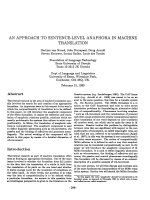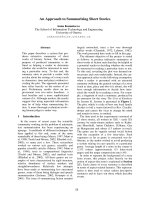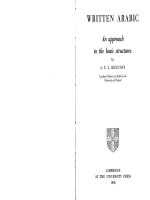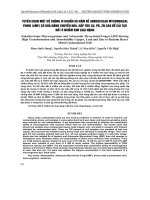Review on Arbuscular mycorrhizal fungi: An approach to overcome drought adversities in plants
Bạn đang xem bản rút gọn của tài liệu. Xem và tải ngay bản đầy đủ của tài liệu tại đây (219.95 KB, 10 trang )
Int.J.Curr.Microbiol.App.Sci (2018) 7(3): 1040-1049
International Journal of Current Microbiology and Applied Sciences
ISSN: 2319-7706 Volume 7 Number 03 (2018)
Journal homepage:
Review Article
/>
Review on Arbuscular Mycorrhizal Fungi: An Approach to Overcome
Drought Adversities in Plants
Zaffar Mahdi Dar1*, Amjad Masood2, Malik Asif1 and Mushtaq Ahamd Malik1
1
Division of Basic Sciences, Faculty of Agriculture SKUAST- K Kashmir J&K, India
2
Division of Agronomy Faculty of Agriculture SKUAST- K Kashmir J&K, India
*Corresponding author
ABSTRACT
Keywords
Arbuscular
mycorhizzae,
Drought, Fungi,
Tolerance
Article Info
Accepted:
10 February 2018
Available Online:
10 March 2018
The ever changing environmental conditions have been faced by plants through
evolutionary time, among which drought is considered as the most common having an
adverse effect on growth and development of the plants which is one of the major
constraints on plant productivity worldwide and is expected to increase with climatic
changes. The symbiotic relationship between arbuscular mycorrhizal (AM) fungi and the
roots of higher plants is widespread in nature. Several ecophysiological studies have
demonstrated that AM symbiosis is a key component in helping plants to cope with water
stress and in increasing drought resistance by bringing about various changes in the host
plant at the morphological level like alterations in root morphology to form a direct
pathway of water uptake by extra radical hyphae. Whereas, the physiological mechanisms
promoting enhanced drought tolerance of the host plant by AM inoculation include
increased photosynthetic rate and nutrient mobilization followed by their rapid uptake
under drought conditions. The biochemical mechanisms promoting drought tolerance in
AM inoculated plants include accumulation of osmoprotectants like proline, sugars and
trehalose and a rapid enhancement in the concentration of different enzymatic and nonenzymatic antioxidants which reduce the risk of free radical attack on the plant cell
membrane which has been evidenced in terms of reduced electrolyte leakage and
malondialdehyde (MDA) content of drought stressed plant tissues in various studies.
Introduction
Crop plants are exposed to several
environmental stresses, all affecting plant
growth and development, which consequently
hampers the productivity of crop plants
(Farooq et al., 2011).
Drought is considered the single most
devastating environmental stress, which
decreases crop productivity more than any
other environmental stress (Lambers et al.,
2008). A continuous shortfall in precipitation
coupled with higher evapotranspiration
demand leads to agricultural drought (Mishra
and Cherkauer, 2010) which is defined as the
lack of ample moisture required for normal
plant growth and development to complete
the life cycle. In plants, a series of
biochemical, physiological and morphological
injuries occur due to water stress depending
on the factors like duration of exposure of
1040
Int.J.Curr.Microbiol.App.Sci (2018) 7(3): 1040-1049
plants to the drought, genetic resistance and
stage of growth (Gong et al., 2013).
AM fungi are composed of fine, tubular
filaments called hyphae. The mass of hyphae
that forms the body of the fungus is called the
mycelium. There are two major classes of
AM fungi: ectotrophic mycorrhizae and
vesicular arbuscular mycorrhizae. Ectotrophic
AM fungi typically show a thick sheath, or
“mantle,” of fungal mycelium around the
roots, and some of the mycelium penetrates
between the cortical cells. The cortical cells
themselves are not penetrated by the fungal
hyphae but instead are surrounded by a
network of hyphae called the hartig net. The
capacity of the root system to absorb nutrients
is improved by the presence of external fungal
hyphae that are much finer than plant roots
and can reach beyond the areas of nutrientdepleted soil near the roots (Clarkson, 1985).
Ectotrophic AM fungi infect exclusively tree
species, including gymnosperms and woody
angiosperms. Unlike the ectotrophic AM
fungi, vesicular AM fungi do not produce a
compact mantle of fungal mycelium around
the root. Instead, the hyphae grow in a less
dense arrangement, both within the root itself
and extending outward from the root into the
surrounding soil. After entering the root
through either the epidermis or a root hair, the
hyphae not only extend through the regions
between cells but also penetrate individual
cells of the cortex. Within the cells, the
hyphae can form oval structures called
vesicles and branched structures called
arbuscules. The arbuscules appear to be sites
of nutrient transfer between the fungus and
the host plant. The association of AM fungi
with plant roots facilitates the uptake of
phosphorus and trace metals such as zinc and
copper. By extending beyond the depletion
zone for phosphorus around the root, the
external mycelium improves phosphorus
absorption. Calculations show that a root
associated with AM fungi can transport
phosphate at a rate more than four times
higher than that of a root not associated with
AM fungi (Nye and Tinker, 1977). Plants
native to arid and semi-arid ecosystems have
their roots highly colonised with AM FUNGI,
which indicates the significance of AM
symbiosis for performance under scarcity of
water.
Keeping in view the changing environmental
conditions and the increased demand for food
and fibre under such conditions, tremendous
efforts are being done to satisfy the demands
placed on agriculture for food and fibre
supply. In order to meet the challenge, a wide
variety of efforts focusing on agro ecosystem
and soil biological system as a whole is
required to understand the stability of process.
Keeping in view the concept of sustainability,
a vehicle for sustainable agriculture has been
hiding secretly for decades in the rhizosphere
in the form of plant growth enhancing
microbes (Navnita et al., 2015). AM fungi is
one of the ancient, diverse and beneficial
groups of such soil microbes which other than
various anti-stress mechanisms released by
the plants during stress can be used to
alleviate the drought adversities.
Hence in the following sections, efforts have
been made to appraise the role and underlying
major mechanisms of AM fungi in plant
tolerance to drought stress.
Effect of AM fungi on various features
promoting drought tolerance
Effect of AM fungi on tissue water
potential
Maintenance of tissue water status is an
important aspect for improved metabolic
activities of the tissues under stressful
environment. Stress tolerant plants through a
number of strategies could maintain high
tissue water status and thereby stress effect is
1041
Int.J.Curr.Microbiol.App.Sci (2018) 7(3): 1040-1049
not felt by the plants. Therefore, maintenance
of tissue water status achieved by different
mechanisms like increased water uptake and
osmoregulation (discussed below) has lot of
relevance for improved growth and
productivity of the plants under stressful
environments.
Effect of AM fungi on water uptake
AM fungus plays an important role in water
economy and is able to endure much drier soil
conditions than most plant life; therefore,
plants with a healthy root mycorrhizal
population benefit and show better survival
under conditions of water stress. Allen and
Boosalis (1983) demonstrated how plants
treated with AM fungus have a greater
tolerance for continued drought. Non
mycorrhizal wheat plants and mycorrhizal
plants were watered to soil saturation and then
allowed to continue transpiring as the soil
dried. The stomata of the non mycorrhizal
plants began closing and were totally closed
after 4 days, but stomata in the mycorrhizal
plants did not begin to close as soon and were
still transpiring after 6 to 7 days. The results
of this study reveal that mycelium maintained
the water uptake even under drought
conditions by entering deeper into the soil in
search of water. A recent finding indicates
that AM fungus play a key role in
modifications of root hairs consequently
helping the plants to overcome the drought
(Li et al., 2014). AM fungi expand the roots
by adding their own expansive network of
absorbing strands to mine the soil for water
and the dissolved minerals carried therein
may also alter the water relations and the
drought tolerance of the plant. Allen et al.,
(1981a) documented that organisms under
water stress conditions exhibited resistance to
water transport, but this resistance was
decreased by up to 90% when mycorrhizae
were introduced. It has been found that AM
fungus improves the hydraulic conductivity
and water uptake of roots hence providing a
low resistance pathway for radial flow of
water across cortex, and contributing towards
better water uptake by the plants (Kothari et
al., 1990). Furthermore, AM fungus may also
regulate the hydraulic properties of plants
through regulation of plasma membrane
intrinsic proteins in combination with
phytohormones (Ruiz-Lozano et al., 2009).
AM fungi mycelia could also improve soil
water holding capacity through enhanced soil
aggregation (Auge, 2001). Improved soil
structure generally improves soil moisture
retention properties and as a result,
mycorrhizal soil may hold more water at a
given soil water potential than non
mycorrhizal soil and thus mycorrhizal plants
will have access to a larger reservoir of soil
water. In association with symbiotic AM
fungi, plants could explore larger volumes of
soil to absorb water and nutrients thereby
impart stress tolerance to the plants (Smith et
al., 2009). Tinker (1984) while summarising
the effects of VAM on increased water uptake
indicated that the probable reason for
increased water uptake are as the better
distribution of absorbing hyphal network,
greater surface area and better extension rate,
altered soil rhizosphere properties, uptake
kinetics, faster water extraction from reduced
water potential soils and hence faster recovery
from the water stress. Hyphae may also
bridge the gap between soil and root that
occurs when soil and root shrink away from
each other when dry.
Effect of AM fungi on osmotic adjustment
Under the condition of water scarcity, water
potential of the root cells may increase as a
result of less stomatal conductance and more
diffusive resistance to carbon dioxide.
Therefore, water potential of the root cells is
required to be reduced in order to maintain
uptake of water from the soil, which in turn is
1042
Int.J.Curr.Microbiol.App.Sci (2018) 7(3): 1040-1049
achieved by accumulation of different solutes
in the cells called as osmoregulation (Munns,
1988).
Osmotic adjustment is one of the important
drought adaptive traits, which has lot of
relevance in maintaining the tissue water
status in plants grown under stressful
conditions. Higher osmotic adjustment
capacity is a characteristic feature of drought
tolerance (Auge, 2001) as it allows the cell to
maintain turgor and turgor dependent
processes like stomatal opening, cellular
expansion, growth, photosynthesis as well as
keeping the water potential gradient
favourable for water entry into the plant root
(Ruiz-Lozano, 2003). When plants are
subjected to stress treatment, they produce
significantly high amount of several
osmolytes and most notable among them are
proline, sugars and trehalose whose
concentration further increases in AM
inoculated plants subjected to drought stress.
Kaya et al., (2009) have reported that the
maize plants in association with AM
accumulated significantly high amount of
proline under salt stress conditions. Similarly
in bell pepper, the proline content was found
to be increased 3 fold in leaves and 2 fold in
roots that suggest the role of AM in
enhancing proline accumulation in different
tissues facilitating plants to maintain tissue
water status (Beltrano et al., 2013). Zhu et al.,
(2011a) have noticed around 56% increase in
proline level with improved osmotic
adjustment in leaves of mycorrhizal plants
than non mycorrhizal plants of maize. There
is a positive correlation between proline
accumulation and AM induced drought
tolerance (Azcon et al., 1996). All these
studies indicate the relevance of AM in
facilitating the plants to go for osmotic
adjustment more quickly for maintaining
better water relations of the plant tissues. Due
to improved osmotic adjustment, the tissue
water status was found to be higher in fungal
associated plants and therefore, these plants
showed greater membrane stability under
stress leading to reduced electrolytes leakage.
This improvement in membrane stability has
also been attributed to increased phosphorus
uptake by AM inoculation and changes
brought about in membrane phospholipids
levels and also in permeability properties
(Evelin et al., 2011). During the period of
inhibited growth, proline serves as nitrogen
and energy source besides reducing the cell
water potential (Kala and Godara, 2011).
Among osmotic solutes, sugars are equally
important as they play an important role in
stabilising cell turgor pressure. AM symbiosis
increases plant growth and photosynthetic rate
which in turn causes increased transport and
building up of carbohydrates in cells which
act as excellent osmoprotectants to lower
osmotic potential (Khalvati et al., 2005).
Studies have shown an increase in sugars
levels in AM plants exposed to drought in
Cyclobalanpsis glauca (Zhang et al., 2014)
and in Poncirus trifoliata (Qiangsheng et al.,
2006). High sugar content of Poncirus
trifoliata
confirms
a
high
natural
physiological metabolism of AM plants under
water stress and well watered conditions
leading to accumulation of carbohydrates
resulting in decrease of osmotic potential of
host cells.
Recently it has been recognized that AM
inoculation may also increase drought
tolerance of nodulated legumes such as
acacia, common bean, lotus, and medicago,
through the biosynthesis of trehalose (Lopez
et al., 2008). Trehalose, a nonreducing
disaccharide, has been found to play a
physiological role as drought stress
protectant. In the nodules, this disaccharide is
synthesized by the bacteroid, and its
accumulation depends on the rhizobial strain,
legume
genotype
and
environmental
conditions. Garcia et al., (2005) and Schubert
et al., (1992) have reported that trehalose
1043
Int.J.Curr.Microbiol.App.Sci (2018) 7(3): 1040-1049
occurs in plants colonized by symbiotic
organisms like AM and rhizobia. The
accumulation of trehalose by different
organisms (bacteria, yeast, fungi, nematodes,
etc.) has been related to survival under
different environmental stresses, like osmotic,
low pH, high and low temperatures and
dehydration (Mahmud, 2009). It was reported
that under well-watered conditions, there is a
basal amount of trehalose in the nodules,
having a negative correlation with the
biological nitrogen fixation, but under
drought conditions, nodule trehalose levels
increase significantly and may contribute to
maintain biological nitrogen fixation under
these circumstances and improve the plant
tolerance to drought. Trehalose accumulation
in an organism protects the cells by stabilizing
cell structures and enables protein to maintain
its native confirmation under drought stress.
However, the role of trehalose induced by
AM fungi in imparting drought tolerance in
crop plants needs more investigation.
Effect of AM fungi on antioxidant level
When plants are subjected to stress, reactive
oxygen species (ROS) such as singlet oxygen,
superoxides,
hydrogen
peroxide,
and
hydroxyl radicals are generated in large
quantity causing oxidative damage to the
plants. ROS are toxic molecules capable of
causing oxidative damage to the lipids, DNA
and proteins (Miller et al., 2010). If these
molecules are not managed properly, they
cause significant damage to the membranes
and cause catastrophic effects on cell
metabolism. Therefore, efficient quenching of
ROS is very crucial for survival and cell
metabolism under stress conditions. Stress
tolerant plants could manage the ROS through
higher activity of antioxidant system (Zhu et
al., 2011a). Oxidative stress occurs when the
antioxidant defence system is overloaded and
is unable to maintain an adequate cellular
redox balance. The antioxidant system
includes both enzymatic (e.g., superoxide
dismutases, ascorbate peroxidases, and
catalases) and non-enzymatic molecules (e.g.,
glutathione, flavonoids, carotenoids, and
tocopherols) (Mittler, 2002).
Earlier studies also suggest that the
mycorrhizal association helps the plants to
overcome the oxidative stress damage and
hence, the plants could continue to grow and
produce without much of yield penalty under
stress conditions. The amelioration of stress
resistance by AM symbiosis is often related to
the enhancement of antioxidant levels or
activities in plants (Baslam and Goicoechea,
2012 and Ruiz-Lozano, 2003) where, they
convert the toxic molecules into non-toxic or
less toxic molecules.
The level of antioxidant enzymes such as
superoxide dismutase, catalase and peroxidase
was found to be significantly high in
mycorrhizal plants than non mycorrhizal
plants when grown under stressful
environment (Khalafallah and Abo Ghalia,
2008) hence decreasing the melondialdehyde
(MDA) content and plasma membrane
conductivity (Baozhong et al., 2010). In
drought stressed lettuce plants, AM increased
the activity of superoxide dismutase in shoot
by 93% (Ruiz Lozano et al., 1996). The
reactive oxygen species generated under
stressful condition were quenched efficiently
by the action of anti-oxidative enzymes and
therefore, the level of reactive oxygen species
was found to be significantly low in AM
inoculated plants.
Besides antioxidant enzymes, the nonenzymatic system also helped to reduce the
level of reactive oxygen species in plants. For
example, in the flowering plant cyclamen,
higher levels of ascorbic acid and polyphenols
besides ascorbate peroxidise and superoxide
dismutase were noticed in leaves, roots and
tubers of stressed plants suggesting the role of
1044
Int.J.Curr.Microbiol.App.Sci (2018) 7(3): 1040-1049
non-antioxidant systems to deal with
oxidative stress (Maya and Matsubara, 2013).
Ruiz Sánchez et al., (2010) found that AM
symbiosis ameliorated the response of plants
to drought by improving photosynthetic
performance but mainly through the
accumulation of the antioxidant compound
glutathione, which was concomitant with a
reduction in oxidative damage to membrane
lipids and to low cellular levels of hydrogen
peroxide. In maize, Zhu et al., (2011b) have
reported low melondialdehyde content in
mycorrhizal plants under drought stress which
was 17.50% lower than that of 365 non
mycorrhizal plants. In several systems,
melondialdehyde has been shown to damage
the membranes and disrupting the cell
metabolism. Therefore, low level of
melondialdehyde observed in maize plants
associated with AM fungi is an indication of
positive effect of AM fungi on reducing the
reactive oxygen species level in plants. These
results perhaps support the argument that the
mycorrhizal plants could tolerate the stress
effects through reduced reactive oxygen
species levels under stress conditions.
Effect of AM fungi on photosynthetic rate
Photosynthesis is generally affected when
plants are subjected to stressful environment.
Change in leaf orientation, leaf area, stomatal
closure, reduced chlorophyll content (Anjum
et al., 2003b), decrease in leaf expansion,
impaired photosynthetic machinery (Fu J. and
Huang, 2001), diminished activities of Calvin
cycle enzymes, premature leaf senescence due
to drought stress are the possible reasons
leading to reduction in photosynthetic rate
and food production in stressed plants (Wahid
and Rasul, 2005 and Monakhova and
Chernyadèv, 2002). When stomatal and non
stomatal limitations to photosynthesis are
compared, the former can be quite small. This
implies that other processes besides CO2
uptake are being damaged due to drought
stress. The role of drought induced stomatal
closure which limits CO2 uptake by leaves, is
very important. In such events, restricted CO2
availability could possibly lead to increased
susceptibility to photo damage (Cornic and
Massacci, 1996).
Mycorrhizal association has been shown to
increase the carbon fixation abilities of the
plants. In a number of systems, higher
photosynthetic rates have been reported when
the plants are in association with AM fungi.
For instance, in black locust, Yang et al.,
(2014) observed high stomatal conductance,
high
transpiration
rates
and
high
photosynthetic rates with reduced internal
CO2 concentration in fungal colonized plants
than the non-colonized plants. Such higher
photosynthetic rate as a consequence of
fungal association has also been reported by
Zhu et al., (2012). They observed high
photosynthetic and transpiration rates in AM
fungi colonized plants of maize than in noncolonized plants both under control and
drought stress conditions. In these plants, the
stomatal conductance was found to be
significantly higher indicating the ability of
the mycorrhizal plants to keep the stomata
wide open to facilitate the exchange of gases
both for transpiration and for photosynthesis
(Subramanian et al., 1995).
Higher photosynthetic rate observed in most
AM inoculated plants is attributed to
enhanced water uptake and maintenance of
high tissue water status followed by high
WUE in these plants. Uptake and movement
of sufficient water to the evaporative surface
helped the plants to maintain guard cell
turgidity leading to opening of stomata for a
gaseous exchange process (Nelsen and Safir,
1982). Through the opened stomata, more
CO2 enters the plants thereby the
photosynthesis is improved in such plants
(Zhu et al., 2011b). As the AM inoculated
plants has the ability to mine water from soil,
1045
Int.J.Curr.Microbiol.App.Sci (2018) 7(3): 1040-1049
it could supply the water requirement of the
evaporative surface and thus, the transpiration
rate was also found to be significantly higher
in fungal colonized plants (Roumet et al.,
2006). Higher rates of photosynthesis in AM
inoculated plants could also be attributed to
higher chlorophyll content of the leaves. The
AM inoculated plants have shown to have
higher chlorophyll content compared to non
AM plants. This observation has been made
by several workers in different systems
(Auge, 2001 and Colla et al., 2008). In pepper
for instance, the chlorophyll content was
shown to be increased by 15-25% to indicate
the relevance of mycorrhizal association in
increasing the pigment content in the leaves
(Beltrano et al., 2013). It has been well
recognised that chlorophyll concentration is
related to photosynthetic rate and chlorophyll
fluorescence. Thus, in AM inoculated plants
an increased rate of chlorophyll has been
associated with the increased rate of
photosynthesis or with higher magnesium and
nitrogen which are major constituents of
chlorophyll (Mathur and Vyas, 1995).
Meanwhile, application of AM fungus helps
the plants to overcome photo destruction and
photoinhibition of pigments under the
conditions of water stress by increasing the
content of carotenoids, as they help in
protection of photosynthetic apparatus against
the harm caused by single oxygen. Therefore,
quenching and deactivation of excited triplet
state of chlorophyll can be brought about by
carotenoids (Foyer and Harbinson, 1994) and
therefore it is clear that the fungal association
is indeed beneficial to plants as it protects the
plants from stress effects.
Water is undisputedly the major factor for the
declining food production in many parts of
the world, particularly in the arid and semiarid regions. Consequently, the world is now
being challenged to produce “more crop per
drop” of water. Therefore, in recent years
there are increasing number of studies to
understand the mechanism by which plants
alleviate drought stress, and AM fungi seems
to be an excellent alternative to serve the
purpose. However, the mechanism by which
AM fungi promotes drought tolerance is still
to be understood well. For example we have a
little knowledge about the increased activities
of the antioxidants in AM inoculated plants
under drought conditions. So the need of the
hour is to understand the mechanism so that a
perfect plant-AM fungi combination can be
formulated for better use of the natural
resources, particularly the water, in arid and
semi-arid regions of the world.
References
Allen, M. F., Sexton, J. C., Moore, T. S. Jr. and
Christensen, M.1981a. Influence of
phosphate source on vesicular-arbuscular
mycorrhizae of Bouteloua gracilis. New
Phytologist. 87: 687-694.
Allen, M. F. and Boosalis, M. G. 1983. Effects of
two species of VA mycorrhizal fungi on
drought tolerance of winter wheat. New
Phytologist. 93: 67–76.
Anjum, F., Yaseen, M., Rasul, E., Wahid, A. and
Anjum, S., 2003b. Water stress in barley
(Hordeum vulgare L.). II. Effect on
chemical composition and chlorophyll
contents. Pakistan J. Agric. Sci. 40: 45–49
Auge, R. M. 2001. Water relations, drought and
vesicular arbuscular mycorrhizal symbiosis.
Mycorrhiza. 11: 3–42.
Azcon, R., Gomez, M., Tobar, R., 1996.
Physiological and nutritional responses by
Lactuca sativa L. to nitrogen sources and
mycorrhizal
fungi
under
drought
conditions. Biology and Fertility of Soils.
22: 155–161.
Baozhong, Y., Wang, Y., Liu, P., Hu, J and Zhen,
W. 2010. Effects of vesicular arbuscular
mycorrhiza on the protective system in
strawberry leaves under drought stress.
Frontiers of Agriculture in China. 4: 165–
169.
Barzana, G., Aroca, R., Bienert, G. P., Chaumont,
F. and Ruiz Lozano, J. M. 2014. New
insights into the regulation of aquaporins by
1046
Int.J.Curr.Microbiol.App.Sci (2018) 7(3): 1040-1049
the arbuscular mycorrhizal symbiosis in
maize plants under drought stress and
possible implications for plant performance.
Molecular Plant Microbe Interaction. 27:
349–363.
Baslam, M. and Goicoechea, N. 2012. Water
deficit improved the capacity of arbuscular
mycorrhizal fungi (AM FUNGI) for
inducing the accumulation of antioxidant
compounds in lettuce leaves. Mycorrhiza.
22:347–359.
Beltrano, J., Ruscitti, M., Arango, M. C. and
Ronco, M. 2013. Effects of arbuscular
mycorrhiza inoculation on plant growth,
biological and physiological parameters and
mineral nutrition in pepper grown under
different salinity and P levels. Journal of
Soil Science and Plant Nutrition. 13: 123–
141.
Clarkson, D. T. 1985. Factors affecting mineral
nutrient acquisition by plants. Annual
Review of Plant Physiology. 36: 77–115.
Colla, G., Rouphael, Y., Cardarelli, M., Tullio,
M., Rivera, C. M. and Rea, E. 2008.
Alleviation of salt stress by arbuscular
mycorrhizal in zucchini plants grown at low
and high phosphorus concentration. Biology
and Fertility of Soils. 44: 501–509.
Cornic, G. and Massacci A. 1996. Leaf
photosynthesis under drought stress. In:
Baker NR, ed. Photosynthesis and the
environment. New York: Kluwer Academic
Publishers, 347–366.
Evelin, H., Giri, B. and Kapoor, R. 2011.
Contribution of Glomus intraradices
inoculation to nutrient acquisition and
mitigation of ionic imbalance in NaClstressed
Trigonella
foenum-graecum.
Mycorrhiza. 1-15.
Farooq, M., H. Bramley, J.A., Palta, and Siddique,
K.H.M. 2011. Heat stress in wheat during
reproductive and grain-filling phases.
Critical Review in Plant Sciences. 30: 491507.
Foyer, C.H. and J. Harbinson, 1994. Oxygen
metabolism and the regulation of
photosynthetic electron transport. In: Foyer,
C.H. and Mullineausx, P. M. (Ed s).
"Causes of photooxidative stress and
amelioration of defense system in plants".
CRC Press, Boca Raton P, 1-14.
Fu, J. and Huang, B. 2001. Involvement of
antioxidants and lipid peroxidation in the
adaptation of two cool-season grasses to
localized drought stress. Environmental and
Experimental Botany. 45: 105–114.
García, N. A., Iribarne, C., López, M., Herrera
Cervera, J. A. and Lluch, C. 2005.
Physiological implications of trehalase
from Phaseolus vulgaris root nodules:
partial purification and characterization.
Plant Physiology and Biochemistry. 43:
355–361.
Gong, B., Wen, D., Vanden Langenberg, K., Wei,
M., Yang, F., Shi, Q. and Wang, X. 2013.
Comparative effects of NaCl and NaHCO3
stress on photosynthetic parameters,
nutrient metabolism, and the antioxidant
system in tomato leaves. Scientia
Horticulture. 157: 1–12.
Kala, S. and Godara, A. K. 2011. Effect of
moisture stress on leaf total proteins,
proline and free amino acid content in
commercial
cultivars
of
Ziziphus
mauritiana. Journal of Scientific Research.
55:65- 69.
Kaya, C., Ashraf, M., Sonmez, O., Aydemir, S.,
Tuna, A.L. and Cullu, M.A. 2009. The
influence of arbuscular mycorrhizal
colonisation on key growth parameters and
fruit yield of pepper plants grown at high
salinity. Scientia Horticulture. 121: 1- 6.
Khalafallah, A. A. and Abo Ghalia, H. H. 2008.
Effect of arbuscular mycorrhizal fungi on
the metabolic products and activity of
antioxidant system in wheat plants
subjected to short –term water stress,
followed by recovery at different growth
stages. Journal of Applied Science and
Research. 4: 559–569.
Khalvati, M. A., Hu, Y., Mozafar, A. and
Schmidhalter U. 2005. Quantification of
water uptake by arbuscular mycorrhizal
hyphae and its significance for leaf growth,
water relations, and gas exchange of barley
subjected to drought stress. Plant Biology.
7(6):706-12.
Kothari, S. K., Marschner, H. and George E.
1990. Effect of VA mycorrhizal fungi and
rhizosphere microorganisms on root and
shoot morphology, growth, and water
1047
Int.J.Curr.Microbiol.App.Sci (2018) 7(3): 1040-1049
relations of maize. New phytologist. 116:
303-311.
Lambers, H., Chapin, F. and Pons, T. 2008. Plant
physiological ecology. Springer, New York,
p 540
Li, C., Yue, J., Wu, X., Xu, C., and Yu, J. (2014).
An ABA-responsive DRE-binding protein
gene from Setaria italica, SiARDP, the
target gene of SiAREB, plays a critical role
under drought stress. Journal of
Experimental Botany. 65: 5415–5427.
Lopez, M., Tejera, N. A., Iribarne, C., Lluch, C.,
and Herrera-Cervera, J. 2008. Trehalose
and trehalase in root nodulae of Medicago
truncatula and Phaseolus vulgaris in
response to salt stress. Physiologia
Plantarum. 134:575–582.
Mahmud, S. A., Nagahisa, K., Hirasawa, T.,
Yoshikawa, K., Ashitani, K., Shimizu, H.
2009. Effect of trehalose accumulation on
response to saline stress in Saccharomyces
cerevisiae. Yeast. 26(1):17–30.
Mathur, N. and Vyas, A.1995. Influence of VA
mycorrhizae on net photosynthesis and
transpiration of Ziziphus mauritiana.
Journal of Plant Physiology. 147: 328-330.
Maya, M. A. and Matsubara, Y. 2013. Influence
of arbuscular mycorrhiza on the growth and
antioxidative activity in cyclamen under
heat stress. Mycorrhiza. 23: 381–390.
Miller, G., Suzuki, N., Ciftci-Yilmaz, S., and
Mittler, R. 2010. Reactive oxygen species
homeostasis and signalling during drought
and
salinity
stresses.
Plant
Cell
Environment. 33: 453–467.
Mishra, V. and Cherkauer, K. A. 2010.
Retrospective droughts in the crop growing
season: Implications to corn and soybean
yield in the midwestern united states.
Agriculture and Forest Meteorology. 150:
1030-1045.
Mittler, R. 2002. Oxidative stress, antioxidants
and stress tolerance. Trends in Plant
Sciences. 7: 405–410.
Monakhova, O.F. and Chernyadèv, I. I. 2002.
Protective role of kartolin-4 in wheat plants
exposed to soil drought. Applied
Biochemistry and Microbiolgy. 38: 373–
380.
Munns, R. 1988. Effect of high external NaCl
concentrations on ion transport within the
shoot of Lupinus albus. I. Ions in xylem
sap. Plant, Cell and Environment. 11: 283–
289.
Navnita, S., Kuldeep, Y., Jagbeer, C., Neetu, B.
and Ashok, A. 2015. Arbuscular
Mycorrhizal Symbiosis and Water Stress: A
Critical Review. Pertanika Journal of
Tropical Agriculture Sciences. 38 (4): 427 –
453.
Nelsen, C. E. and Safir, G. R. 1982. The water
relations of well watered, mycorrhizal and
non mycorrhizal onion plants. Journal of
American Society of Horticultural Science.
107: 271 –274.
Nye, P.H. and Tinker, P.B. 1977. Solute
movement in the soil-root system.
Blackwell Scientific Publ., Oxford, England
Ocon, A., Hampp, R. and Requena, N. 2007.
Trehalose turnover during abiotic stress in
arbuscular
mycorrhizal
fungi.
New
Phytologist. 174: 879–891.
Qiangsheng, W. U. and Renxue, X. I. A. 2006.
Effects of arbuscular mycorrhizal fungi on
leaf solutes Arbuscular Mycorrhizal
Symbiosis and Water Stress: Frontier for
China. 3: 312-317.
Roumet, C., Urcelay, C. and Díaz, S. (2006).
Suites of root traits differ between annual
and perennial species growing in the field.
New Phytologist. 170: 357–68.
Ruiz Lozano, J. M. 2003. Arbuscular mycorrhizal
symbiosis and alleviation of osmotic stress.
New perspectives for molecular studies.
Mycorrhiza. 13: 309–317.
Ruiz-Lozano, J. M., Alguacil, M. M., Bárzana, G.,
Vernieri, P. and Aroca, R. 2009. Exogenous
ABA accentuates the differences in root
hydraulic properties between mycorrhizal
and non mycorrhizal maize plants through
regulation of PIP aquaporins. Plant
Molecular Biology. 70: 565-579.
Ruiz-Lozano, J. M., Azcón, R. and Gómez M.
1996. Alleviation of salt stress by
arbuscular mycorrhizal Glomusspecies in
Lactuca
sativa
plants.
Physiologia
Plantarum. 98: 767–772.
Ruiz-Sanchez, M., Aroca, R., Munoz, Y.,
Armada, E., Polon, R. and Ruiz-Lozano, J.
M. 2010. The arbuscular mycorrhizal
symbiosis enhances the photosynthetic
efficiency and the antioxidative response of
1048
Int.J.Curr.Microbiol.App.Sci (2018) 7(3): 1040-1049
rice plants subjected to drought stress.
Journal of Plant Physiology. 167:862–869.
Schubert, A., Wyss, P. and Wiemken A. 1992.
Occurrence of trehalose in vesiculararbuscular mycorrhizal fungi and in
mycorrhizal roots. Journal of Plant
Physiology. 140: 41–45.
Smith, F. A., Grace, E. J. and Smith, S. E. 2009.
More than a carbon economy: nutrient trade
and ecological sustainability in facultative
arbuscular mycorrhizal symbioses. New
Phytologist. 182:347–358.
Subramanian, K. S., Charest, C., Dwyer, L. M.
and Hamilton, R. I. 1995. Arbuscular
mycorrhiza and water relations in maize
under drought stress at tasselling. New
Phytologist. 129: 643–650.
Tinker, P. B. 1984. The role of microorganisms in
mediating and facilitating the uptake of
plant nutrients from soil. Plant and Soil. 76:
77–91.
Wahid, A. and Rasul, E. 2005. Photosynthesis in
leaf, stem, flower and fruit, in: Pessarakli
M. (Ed.), Handbook of Photosynthesis, 2nd
ed., CRC Press, Florida, pp. 479–497
Yang, Y., Tang, M., Sulpice, R., Chen, H., Tian,
S. and Ban, Y. 2014. Arbuscular
mycorrhizal fungi alter fractal dimension
characteristics of Robinia pseudoacacia L.
seedlings through regulating plant growth,
leaf water status, photosynthesis, and
nutrient concentration under drought stress.
Journal of Plant Growth Regulators. 33:
612–625.
Zhang, J. Y., Cruz, D., Torres-Jerez, I., Kang, Y.,
Allen, S. N., Huhman, D. V., Tang, Y.,
Murray, J., Sumner, L. W. and Udvardi, M.
K. (2014). Global reprogramming of
transcription and metabolism in Medicago
truncatula during progressive drought and
after rewatering. Plant Cell Environment.
37:2553–76.
Zhu, X. C., Song, F. B., Liu, S. Q., Liu, T. D and
Zhou, X. (2012). Arbuscular mycorrhizae
improve photosynthesis and water status of
Zea mays L. under drought stress. Plant
Soil and Environment. 58(4): 186-191.
Zhu, X., Song, F. and Liu, S. 2011a. Arbuscular
mycorrhiza impacts on drought stress of
maize plants by lipid peroxidation, proline
content and activity of antioxidant system.
Journal of Food, Agriculture and
Environment. 9: 583–587.
Zhu, X., Song, F. B., Liu, S., and Liu, T. 2011b.
Effects of arbuscular mycorrhizal fungus on
photosynthesis and water status of maize
under high temperature stress. Plant and
Soil. 346: 189–199.
How to cite this article:
Zaffar Mahdi Dar, Amjad Masood, Malik Asif and Mushtaq Ahamd Malik. 2018. Review on
Arbuscular Mycorrhizal Fungi: An Approach to Overcome Drought Adversities in Plants.
Int.J.Curr.Microbiol.App.Sci. 7(03): 1040-1049. doi: />
1049









